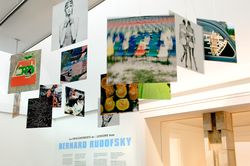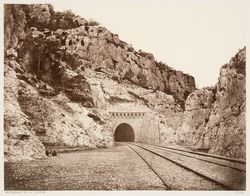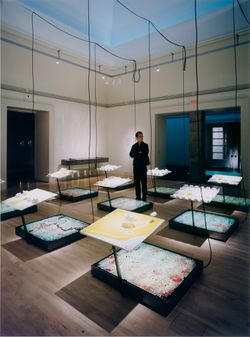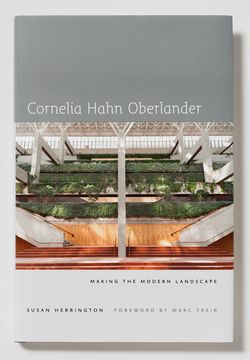Lessons from Bernard Rudofsky is the first retrospective to examine the life and work of the controversial architect, designer, and critic whose groundbreaking buildings, exhibitions, and fashion designs challenged the Western world’s perceptions of comfort and culture. The exhibition highlights the diverse contributions of a unique and underappreciated pioneer of(...)
Main galleries
4 July 2007 to 30 September 2007
Lessons from Bernard Rudofsky
Actions:
Description:
Lessons from Bernard Rudofsky is the first retrospective to examine the life and work of the controversial architect, designer, and critic whose groundbreaking buildings, exhibitions, and fashion designs challenged the Western world’s perceptions of comfort and culture. The exhibition highlights the diverse contributions of a unique and underappreciated pioneer of(...)
Main galleries
research
Visiting Scholars 2005
Paolo Amaldi, Université catholique de Louvain (UCL), Louvain-La-Neuve, Belgium Topic: Analyse du rapport entre espace architectural et instrument de représentation dans l’oeuvre de Mies van der Rohe Jean-François Bédard, Paris Program, Columbia University, New York, United States Topic: Honnêteté and the Grotesque: a Study of the Album by Gilles-Marie Oppenord(...)
3 January 2005 to 30 September 2005
Visiting Scholars 2005
Actions:
Description:
Paolo Amaldi, Université catholique de Louvain (UCL), Louvain-La-Neuve, Belgium Topic: Analyse du rapport entre espace architectural et instrument de représentation dans l’oeuvre de Mies van der Rohe Jean-François Bédard, Paris Program, Columbia University, New York, United States Topic: Honnêteté and the Grotesque: a Study of the Album by Gilles-Marie Oppenord(...)
research
3 January 2005 to
30 September 2005
textual records
AP197.S1.SS9.014
Description:
The box contains drafts, final copies, notes and correspondence for various articles, interviews, keynote addresses, and lectures by Kenneth Frampton. The materials are organized in alphabetical order, from FR- I. The largest portion of this box consists of articles, correspondence and research files on Tony Fretton; a dossier on the 1994 Mies van der Rohe Pavilion Award in which Frampton was a nominator from 1994-1996; various articles, drafts and correspondence on Steven Holl; drafts of "Homage a Finlandia: Finnish Architecture and the Unfinished Modern Project," a Nils Wickberg lecture, Aalto University; and correspondence and drafts of a Michael Hopkins essay featured in "Hopkins: the work of Michael Hopkins and Partners." Other subjects and architects explored in these texts relate to: Tony Fretton; Hiromi Fuiji; futurism; on Galfetti's Aula; Antoni Gaudí; globalism and its discontents; Giorgio Grassi; Vittorio Gregotti; the Guggenheim; Dan S. Hanganu; the work of Hariri Hariri; Herman Hertzberger; homage to Iberia; industrialization; and an introduction to "Inside Architecture" by Vittorio Gregotti.
circa 1971-2015
Kenneth Frampton writings (FR-I)
Actions:
AP197.S1.SS9.014
Description:
The box contains drafts, final copies, notes and correspondence for various articles, interviews, keynote addresses, and lectures by Kenneth Frampton. The materials are organized in alphabetical order, from FR- I. The largest portion of this box consists of articles, correspondence and research files on Tony Fretton; a dossier on the 1994 Mies van der Rohe Pavilion Award in which Frampton was a nominator from 1994-1996; various articles, drafts and correspondence on Steven Holl; drafts of "Homage a Finlandia: Finnish Architecture and the Unfinished Modern Project," a Nils Wickberg lecture, Aalto University; and correspondence and drafts of a Michael Hopkins essay featured in "Hopkins: the work of Michael Hopkins and Partners." Other subjects and architects explored in these texts relate to: Tony Fretton; Hiromi Fuiji; futurism; on Galfetti's Aula; Antoni Gaudí; globalism and its discontents; Giorgio Grassi; Vittorio Gregotti; the Guggenheim; Dan S. Hanganu; the work of Hariri Hariri; Herman Hertzberger; homage to Iberia; industrialization; and an introduction to "Inside Architecture" by Vittorio Gregotti.
textual records
circa 1971-2015
drawings, graphic materials
Posters and prints
AP197.S4.010
Description:
This box contains various drawings and collages, some of which are dedicated to Frampton. The box also comprises of posters for lectures/conferences/events that Frampton may have either participated in or attended. Posters include: the lecture on the Imaginary space of El Lissitzky, Harvard University; Place, form, and cultural identity, École polytechnique fédérale de Lausanne; the Alcan Lectures, McGill University; and Modern Architecture and Critique of Ulm, the University of Southern California. Also included in the box is a poster of the Museum of Contemporary Art Los Angeles, which is signed by Arata Isozaki.
circa 1978-2015
Posters and prints
Actions:
AP197.S4.010
Description:
This box contains various drawings and collages, some of which are dedicated to Frampton. The box also comprises of posters for lectures/conferences/events that Frampton may have either participated in or attended. Posters include: the lecture on the Imaginary space of El Lissitzky, Harvard University; Place, form, and cultural identity, École polytechnique fédérale de Lausanne; the Alcan Lectures, McGill University; and Modern Architecture and Critique of Ulm, the University of Southern California. Also included in the box is a poster of the Museum of Contemporary Art Los Angeles, which is signed by Arata Isozaki.
drawings, graphic materials
circa 1978-2015
Édouard Baldus, more than any other photographer, defined the modern landscape and established the standard for architectural photography. The Photographs of Édouard Baldus: Landscapes and Monuments of France chronicles the Golden Age of France as seen by the photographer. The Photographs of Édouard Baldus is organized by chronological sections to reveal the evolution of(...)
Main galleries
25 January 1995 to 23 April 1995
The Photographs of Édouard Baldus: Landscapes and Monuments of France
Actions:
Description:
Édouard Baldus, more than any other photographer, defined the modern landscape and established the standard for architectural photography. The Photographs of Édouard Baldus: Landscapes and Monuments of France chronicles the Golden Age of France as seen by the photographer. The Photographs of Édouard Baldus is organized by chronological sections to reveal the evolution of(...)
Main galleries
textual records
AP197.S1.SS9.001
Description:
This box contains notes, drafts, articles, book reviews and lectures by Kenneth Frampton. The materials are organized alphabetically by either title or the architect's last name, from A-Z. The contents are mostly older texts by Frampton, circa 1960-1990. Subjects and architects explored in these texts include: Raimund Abraham; Tadao Ando; contemporary architecture; the modern urban form; Gustave Eiffel; English neoclassicism; Louis Kahn; John Hejduk; Herman Hertzberger; postmodern theory; Steven Holl; industrialization; Le Corbusier; El Lissitzky; modernism; Palais Royale; Carlo Scarpa; James Stirling; Team 10; technology; and Otto Wagner.
circa 1964-1990
Kenneth Frampton texts, articles and notes (A-Z)
Actions:
AP197.S1.SS9.001
Description:
This box contains notes, drafts, articles, book reviews and lectures by Kenneth Frampton. The materials are organized alphabetically by either title or the architect's last name, from A-Z. The contents are mostly older texts by Frampton, circa 1960-1990. Subjects and architects explored in these texts include: Raimund Abraham; Tadao Ando; contemporary architecture; the modern urban form; Gustave Eiffel; English neoclassicism; Louis Kahn; John Hejduk; Herman Hertzberger; postmodern theory; Steven Holl; industrialization; Le Corbusier; El Lissitzky; modernism; Palais Royale; Carlo Scarpa; James Stirling; Team 10; technology; and Otto Wagner.
textual records
circa 1964-1990
Sub-series
CI001.S2.D5
Description:
Charles Rohault de Fleury was architect for the Muséum national d'histoire naturelle from 1833 to 1862. His work for the Muséum is represented in the CCA collection by a diverse group of prints and drawings. In addition to documenting his built and unbuilt projects, the inclusion of prints and drawings of museum and zoo buildings by other architects record, if only partially, the resources available to Charles in designing his buildings. This reference material provides insight into the influences on Charles' work as well as the nature of the design process itself. His built works, with the exception of the 1854 addition to the greenhouses, are illustrated in a book of prints with a brief accompanying text - "Muséum d'histoire naturelle: serres chaudes, galeries de minéralogie, etc. etc." (published 1837) (DR1974:0002:004:001; a second copy is held by the CCA library) (1). While prints are included for the Galerie de minéralogie et de géologie, the monkey house and the reservoirs, the majority of the prints are of the greenhouses (serres chaudes) begun 1833 (2). Known for their technological innovations in iron construction, these greenhouses utilized the first multi-storey load-bearing cast-iron façades for the central pavilions as well as space frame roof structures and prefabricated parts. This structural system is well documented in the prints in the CCA collection. The design was apparently inspired by the English greenhouses - a plate of which are included in the book - that Charles saw on a tour of England. The use of prestressed beams and curved roofs in the lateral wings attest to this influence. Charles' greenhouses, in turn, influenced the design of other greenhouses in Europe especially those at the Jardins Botanique in Liège and Ghent, Belgium (3). Although Joseph Paxton saw the greenhouses in 1833, it is unclear if they had an impact on the design of the Crystal Palace constructed 1850-1851 (4). The innovations of Charles' greenhouses continued to be acknowledged into the 20th century. Giedion in "Space, Time and Architecture", while erroneously attributing them to Rouhault (5)(6), refers to the greenhouses as "the prototype of all large iron-framed conservatories" (7). In addition to the greenhouses for the Muséum, the CCA collection includes three proposals (dated 1841) for a private greenhouse designed by Charles Rohault de Fleury (DR1974:0002:002:008 - DR1974:0002:002:013). The designs utilize the same curved roofs as the wings of the greenhouses at the Muséum combined with classically detailed stonework. An different aspect of Charles' work for the Muséum national d'histoire naturelle is represented in the album of unexecuted proposals -the only design drawings for the Muséum in the collection - for a Galerie de zoologie (DR1974:0002:024:001-079). Building on the typology of his earlier classical Galerie de minéralogie et de géologie (constructed 1833 -1841), the proposals, which date from between 1838 and 1862, illustrate a gradual enrichment of Charles' classical architectural vocabulary (8). They vary in their spatial configurations and façade treatments ranging from austere colonnaded designs with little ornament to more elaborate ones with richly encrusted facades, complex rooflines and more dramatic interior spaces characteristic of the Second Empire. The majority of the proposals consist of preliminary drawings illustrating the essential formal, spatial and ornamental aspects of the building. One proposal, dated January 1846, is substantially more developed than the others; in addition to general plans, sections and elevations, more detailed drawings are included for the layout of spaces, the elaboration of the facades, the configuration of the structure and even the designs for the specimen display cases. It is also worth noting that this album includes several plans outlining Rohault de Fleury's ideas for the overall development of the Muséum national d'histoire naturelle. In 1846, an album of prints of the Museo di fiscia e storia naturelle in Florence (DR1974:0002:005:001-018) was presented to Charles by the Grand Duke of Tuscany in response to his request for tracings of that building. These prints were probably used as reference material for the design of the new Galerie de zoologie described above. The portfolio of record drawings (ca. 1862) of the zoos in Antwerp, Brussels, Marseille and Amsterdam (DR1974:0002:018:001-027) is probably a dummy for a publication on zoological gardens as well as background documentation for the renovation and expansion of the zoo at the Muséum national d'histoire naturelle in Paris. Both drawings of the facilities for the animals and visitors and general plans of the zoological gardens are included. The Paris zoo project was apparently never undertaken. (1) These prints were reused in the "Oeuvre de C. Rohault de Fleury, architecte" (published 1884) (DR1974:0002:029:001-044). (2) Rohault de Fleury's greenhouses were destroyed in the Prussian bombardments of 1870. The greenhouses, which now stand in their place, are similar in layout and appearance to the original design, but their structural system is different. (3) John Hix, 'The Glass House' (Cambridge, Mass.: The MIT Press, 1981), p. 115. (4) Ibid., p. 115. (5) This error has been repeated by other authors including Henry-Russell Hitchcock, 'Architecture: Nineteenth and Twentieth Centuries' (Baltimore, Maryland: Penguin Books, 1968), p. 120. (6) Leonardo Benevolo, 'History of Modern Architecture' Volume 1: The tradition of modern architecture (Cambridge, Mass.: The M.I.T. Press, 1971), p. 22. (7) Sigfried Giedion, 'Space, Time and Architecture; the growth of a new tradition' (Cambridge: Harvard University Press, 1941), p. 181. (8) Barry Bergdoll, "Charles Rohault de Fleury: Part two: Muséum d'Histoire Naturelle and Studies on analogous Constructions in Europe", 'CCA Research Report", n.d., p. 1.
[1837-ca. 1862]
Muséum nationale d'histoire naturelle
CI001.S2.D5
Description:
Charles Rohault de Fleury was architect for the Muséum national d'histoire naturelle from 1833 to 1862. His work for the Muséum is represented in the CCA collection by a diverse group of prints and drawings. In addition to documenting his built and unbuilt projects, the inclusion of prints and drawings of museum and zoo buildings by other architects record, if only partially, the resources available to Charles in designing his buildings. This reference material provides insight into the influences on Charles' work as well as the nature of the design process itself. His built works, with the exception of the 1854 addition to the greenhouses, are illustrated in a book of prints with a brief accompanying text - "Muséum d'histoire naturelle: serres chaudes, galeries de minéralogie, etc. etc." (published 1837) (DR1974:0002:004:001; a second copy is held by the CCA library) (1). While prints are included for the Galerie de minéralogie et de géologie, the monkey house and the reservoirs, the majority of the prints are of the greenhouses (serres chaudes) begun 1833 (2). Known for their technological innovations in iron construction, these greenhouses utilized the first multi-storey load-bearing cast-iron façades for the central pavilions as well as space frame roof structures and prefabricated parts. This structural system is well documented in the prints in the CCA collection. The design was apparently inspired by the English greenhouses - a plate of which are included in the book - that Charles saw on a tour of England. The use of prestressed beams and curved roofs in the lateral wings attest to this influence. Charles' greenhouses, in turn, influenced the design of other greenhouses in Europe especially those at the Jardins Botanique in Liège and Ghent, Belgium (3). Although Joseph Paxton saw the greenhouses in 1833, it is unclear if they had an impact on the design of the Crystal Palace constructed 1850-1851 (4). The innovations of Charles' greenhouses continued to be acknowledged into the 20th century. Giedion in "Space, Time and Architecture", while erroneously attributing them to Rouhault (5)(6), refers to the greenhouses as "the prototype of all large iron-framed conservatories" (7). In addition to the greenhouses for the Muséum, the CCA collection includes three proposals (dated 1841) for a private greenhouse designed by Charles Rohault de Fleury (DR1974:0002:002:008 - DR1974:0002:002:013). The designs utilize the same curved roofs as the wings of the greenhouses at the Muséum combined with classically detailed stonework. An different aspect of Charles' work for the Muséum national d'histoire naturelle is represented in the album of unexecuted proposals -the only design drawings for the Muséum in the collection - for a Galerie de zoologie (DR1974:0002:024:001-079). Building on the typology of his earlier classical Galerie de minéralogie et de géologie (constructed 1833 -1841), the proposals, which date from between 1838 and 1862, illustrate a gradual enrichment of Charles' classical architectural vocabulary (8). They vary in their spatial configurations and façade treatments ranging from austere colonnaded designs with little ornament to more elaborate ones with richly encrusted facades, complex rooflines and more dramatic interior spaces characteristic of the Second Empire. The majority of the proposals consist of preliminary drawings illustrating the essential formal, spatial and ornamental aspects of the building. One proposal, dated January 1846, is substantially more developed than the others; in addition to general plans, sections and elevations, more detailed drawings are included for the layout of spaces, the elaboration of the facades, the configuration of the structure and even the designs for the specimen display cases. It is also worth noting that this album includes several plans outlining Rohault de Fleury's ideas for the overall development of the Muséum national d'histoire naturelle. In 1846, an album of prints of the Museo di fiscia e storia naturelle in Florence (DR1974:0002:005:001-018) was presented to Charles by the Grand Duke of Tuscany in response to his request for tracings of that building. These prints were probably used as reference material for the design of the new Galerie de zoologie described above. The portfolio of record drawings (ca. 1862) of the zoos in Antwerp, Brussels, Marseille and Amsterdam (DR1974:0002:018:001-027) is probably a dummy for a publication on zoological gardens as well as background documentation for the renovation and expansion of the zoo at the Muséum national d'histoire naturelle in Paris. Both drawings of the facilities for the animals and visitors and general plans of the zoological gardens are included. The Paris zoo project was apparently never undertaken. (1) These prints were reused in the "Oeuvre de C. Rohault de Fleury, architecte" (published 1884) (DR1974:0002:029:001-044). (2) Rohault de Fleury's greenhouses were destroyed in the Prussian bombardments of 1870. The greenhouses, which now stand in their place, are similar in layout and appearance to the original design, but their structural system is different. (3) John Hix, 'The Glass House' (Cambridge, Mass.: The MIT Press, 1981), p. 115. (4) Ibid., p. 115. (5) This error has been repeated by other authors including Henry-Russell Hitchcock, 'Architecture: Nineteenth and Twentieth Centuries' (Baltimore, Maryland: Penguin Books, 1968), p. 120. (6) Leonardo Benevolo, 'History of Modern Architecture' Volume 1: The tradition of modern architecture (Cambridge, Mass.: The M.I.T. Press, 1971), p. 22. (7) Sigfried Giedion, 'Space, Time and Architecture; the growth of a new tradition' (Cambridge: Harvard University Press, 1941), p. 181. (8) Barry Bergdoll, "Charles Rohault de Fleury: Part two: Muséum d'Histoire Naturelle and Studies on analogous Constructions in Europe", 'CCA Research Report", n.d., p. 1.
File 5
[1837-ca. 1862]
The American Lawn: Surface of Everyday Life reveals the lawn as a domestic symbol, civic showplace, economic force, and national icon. Bungalows in tract developments, suburban corporate headquarters, and the White House are all alike in that they sit behind a lawn: a carefully contrived patch of “nature” that lies open to the sky and to a multitude of uses and(...)
Main galleries, octagonal gallery, and hall cases
16 June 1998 to 8 November 1998
The American Lawn: Surface of Everyday Life
Actions:
Description:
The American Lawn: Surface of Everyday Life reveals the lawn as a domestic symbol, civic showplace, economic force, and national icon. Bungalows in tract developments, suburban corporate headquarters, and the White House are all alike in that they sit behind a lawn: a carefully contrived patch of “nature” that lies open to the sky and to a multitude of uses and(...)
Main galleries, octagonal gallery, and hall cases
The first biography of one of the most influential landscape architects of the 20th century, Cornelia Hahn Oberlander: Making the Modern Landscape draws upon archival research, site analyses, and numerous interviews with Cornelia Oberlander and her collaborators. Author Susan Herrington joins Oberlander in conversation about her works and career. The series They want(...)
14 September 2014 , 3pm
Cornelia Oberlander and Susan Herrington want to speak with you
Actions:
Description:
The first biography of one of the most influential landscape architects of the 20th century, Cornelia Hahn Oberlander: Making the Modern Landscape draws upon archival research, site analyses, and numerous interviews with Cornelia Oberlander and her collaborators. Author Susan Herrington joins Oberlander in conversation about her works and career. The series They want(...)
Project
AP056.S1.2000.PR05
Description:
This project series documents the James Stewart Centre for Mathematics at McMaster University in Hamilton, Ontario from 2000-2003. The office identified the project number as 2000-22. This project consisted of the complete interior renovation of Hamilton Hall, originally built in 1929, for use as a mathematics school at the University. An insulated envelope was added to the historic building in order to preserve its gothic exteriors, which were juxtaposed against new modern and abstract interior spaces. Transparent blue glass was used throughout the four-storey building for walls, ceilings and railings to draw sunlight deep into its interiors. A mix of enclosed rooms and open, interactive spaces were created and slate chalkboards were added throughout the building to inspire spontaneous thought and collaborative work.[1] This project was awarded a Governor General's Medal in Architecture in 2004. The project is recorded through drawings dating from around 2000 to around 2002, which include sketches, plans, elevations, sections, perspectives, details, presentation drawings and digital renderings. A large part of the sketches are drawings for custom furniture. [1]"James Stewart Centre for Mathematics, McMaster University." KPMB. Accessed April 12, 2019. http://www.kpmb.com/project/james-stewart-centre-for-mathematics/
circa 2000-2002
James Stewart Centre for Mathematics, McMaster University, Hamilton, Ontario (2000-2003)
Actions:
AP056.S1.2000.PR05
Description:
This project series documents the James Stewart Centre for Mathematics at McMaster University in Hamilton, Ontario from 2000-2003. The office identified the project number as 2000-22. This project consisted of the complete interior renovation of Hamilton Hall, originally built in 1929, for use as a mathematics school at the University. An insulated envelope was added to the historic building in order to preserve its gothic exteriors, which were juxtaposed against new modern and abstract interior spaces. Transparent blue glass was used throughout the four-storey building for walls, ceilings and railings to draw sunlight deep into its interiors. A mix of enclosed rooms and open, interactive spaces were created and slate chalkboards were added throughout the building to inspire spontaneous thought and collaborative work.[1] This project was awarded a Governor General's Medal in Architecture in 2004. The project is recorded through drawings dating from around 2000 to around 2002, which include sketches, plans, elevations, sections, perspectives, details, presentation drawings and digital renderings. A large part of the sketches are drawings for custom furniture. [1]"James Stewart Centre for Mathematics, McMaster University." KPMB. Accessed April 12, 2019. http://www.kpmb.com/project/james-stewart-centre-for-mathematics/
project
circa 2000-2002



